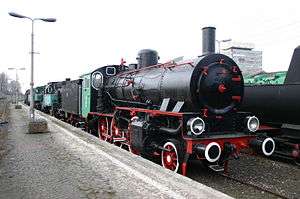Prussian P 6
| Prussian P 6 DRG Class 37.0–1 PKP Oi1 | |
|---|---|
 | |
| Number(s) | DRG 37 001–163 |
| Quantity | 275 |
| Manufacturer | Hohenzollern, Schwartzkopff |
| Year(s) of manufacture | 1902–1910 |
| Retired | about 1950 |
| Wheel arrangement | 2-6-0 |
| Axle arrangement | 1'C h2 |
| Gauge | 1,435 mm (4 ft 8 1⁄2 in) standard gauge |
| Length over buffers | 17,608 mm (57 ft 9 1⁄4 in) |
| Service weight | 57.1 t (56.2 long tons; 62.9 short tons) |
| Adhesive weight | 44.6 t (43.9 long tons; 49.2 short tons) |
| Axle load | 15.2 t (15.0 long tons; 16.8 short tons) |
| Top speed | 90 km/h (56 mph) |
| Indicated Power | 755 kW (1,012 hp) |
| Driving wheel diameter | 1,600 mm (62.99 in) |
| Leading wheel diameter | 1,000 mm (39.37 in) |
| No. of cylinders | 2 |
| Cylinder bore | 540 mm (21.26 in) |
| Piston stroke | 630 mm (24.80 in) |
| Boiler Overpressure | 12 bar (1,200 kPa; 170 psi) |
| Grate area | 2.28 m2 (24.5 sq ft) |
| Superheater area | 41.91 m2 (451.1 sq ft) |
| Evaporative heating area | 134.93 m2 (1,452.4 sq ft) |
| Tender | pr 2'2' T 16 |
| Water capacity | 16.0 m3 (3,500 imp gal; 4,200 US gal) |
The Prussian Class P 6s were passenger locomotives operated by the Prussian state railways with a leading axle and three coupled axles.
The P 6 was conceived as a so-called universal locomotive. The first vehicle was manufactured in 1902 at Düsseldorf by the firm of Hohenzollern. This engine has a number of features that are characteristic of its designer, Robert Garbe: a narrow chimney located well forward and the unusual position of the boiler. As a result, and in spite of the relatively small, 1,600 mm (62.99 in) diameter, driving wheels (on the prototype they were only 1,500 mm or 59.06 in), the locomotives were authorised to travel at up to 90 km/h (56 mph), a speed which could not be attained in practice due to its poor riding qualities.
The smokebox superheater installed on the first machines was soon replaced by a smoke tube superheater. In all, 275 engines of this class were built up to 1910. 110 examples had to be handed over after the First World War as reparations. 163 locomotives were taken over by the Deutsche Reichsbahn as DRG Class 37.0-1, where they were allocated the running numbers 37 001–163. The locomotives with numbers 37 201–206 were, by contrast, G 6 and P 6 class engines respectively of Lübeck-Büchen Railway (LBE), that had a different design from the Prussian locomotives.
The Prussian P 6s were retired by about 1950. The few engines left after the Second World War were no longer employed by the Deutsche Bundesbahn and the Reichsbahn.
The locomotives taken over by the Polish State Railways (PKP) were given the designation Oi1. One of them has been preserved and can be viewed in the Warsaw Railway Museum. The engines were equipped with Prussian tenders of class pr 2'2' T 16.
See also
- Prussian state railways
- List of Prussian locomotives and railcars
- List of preserved steam locomotives in Germany
| Wikimedia Commons has media related to Prussian P 6. |